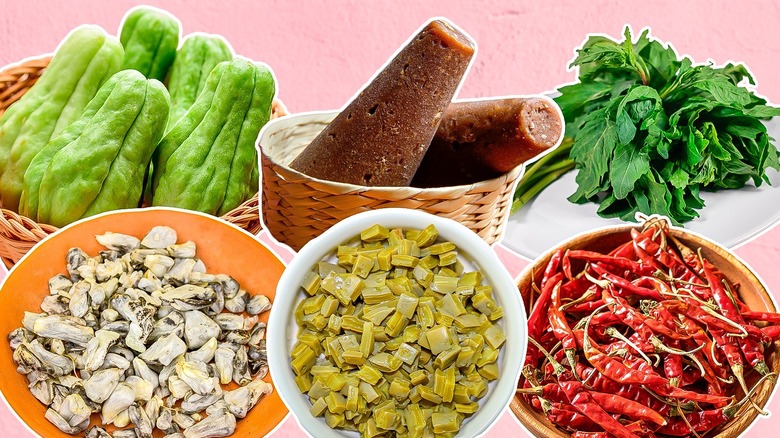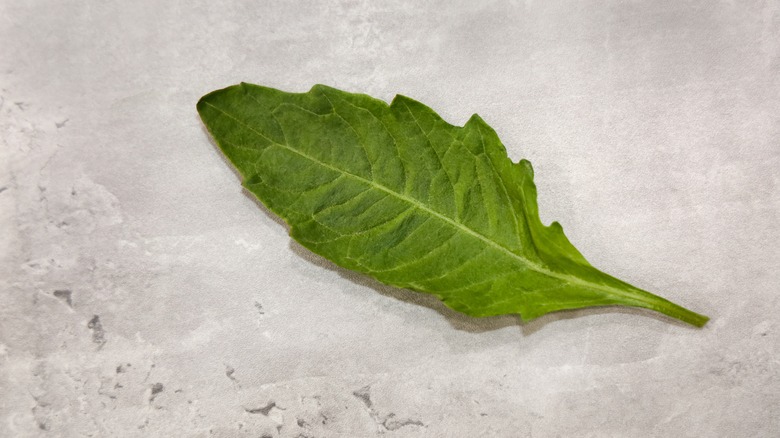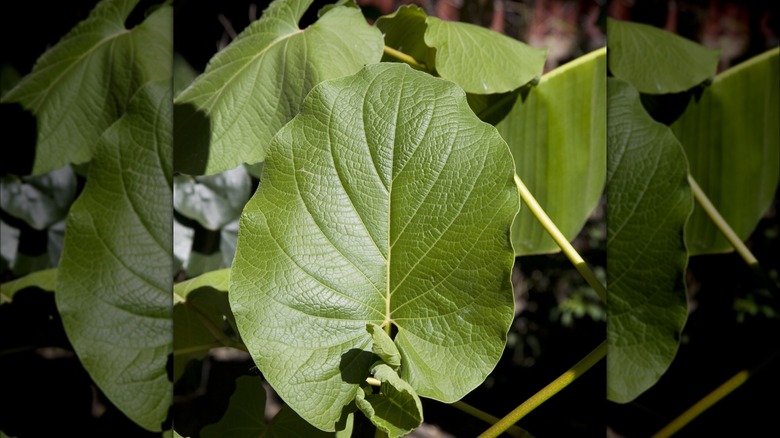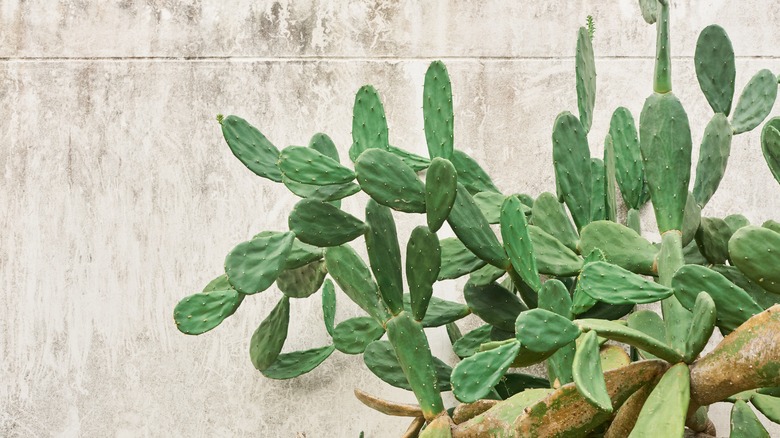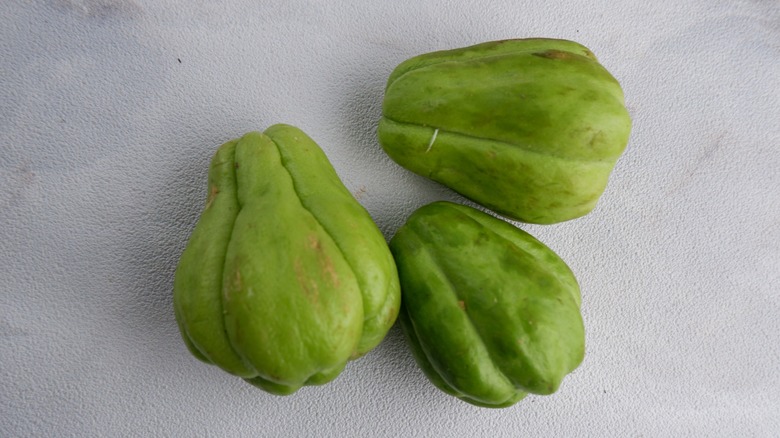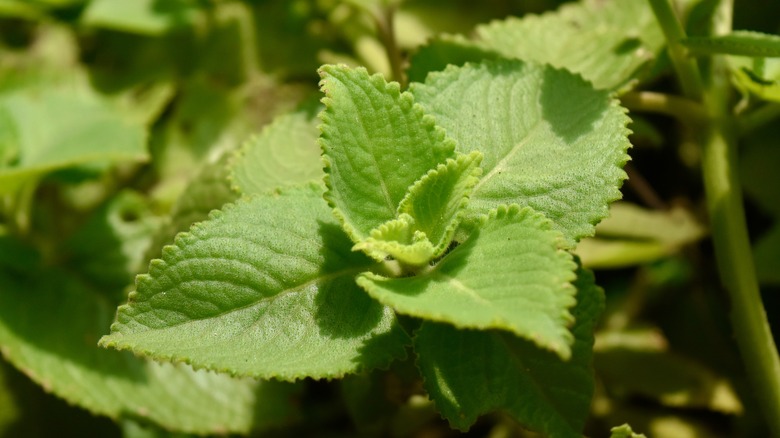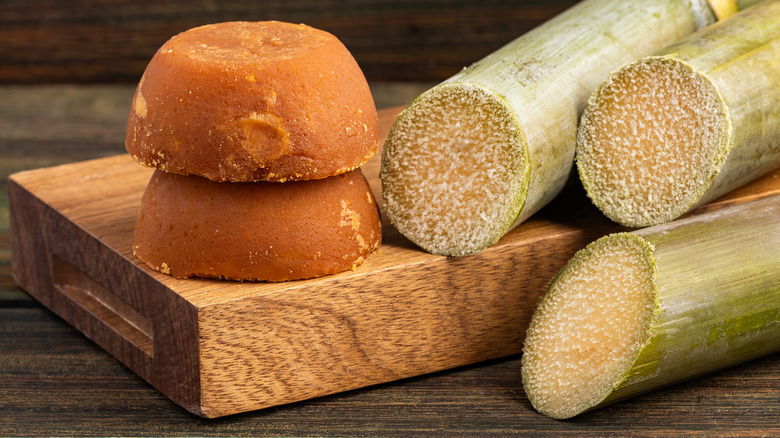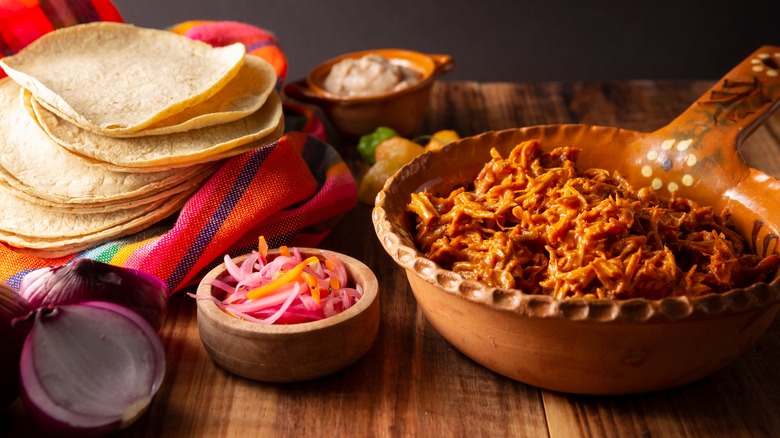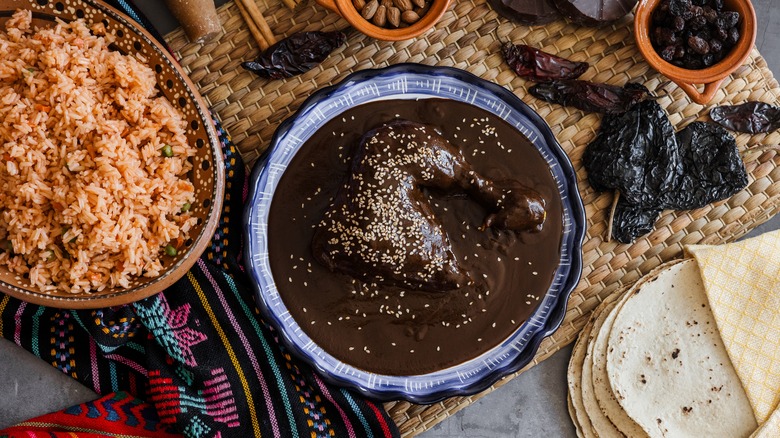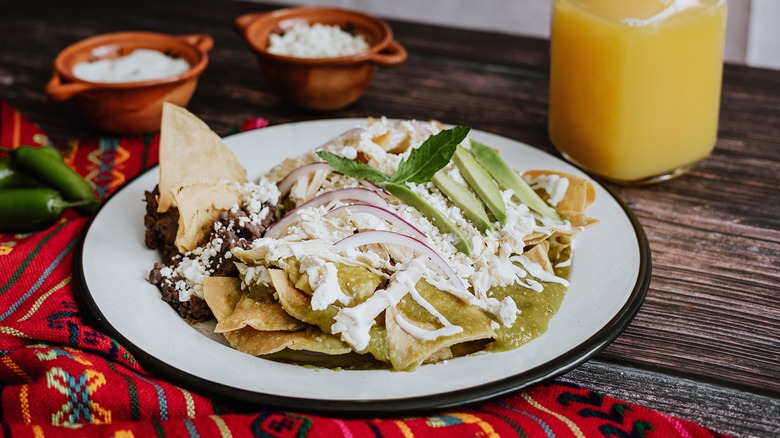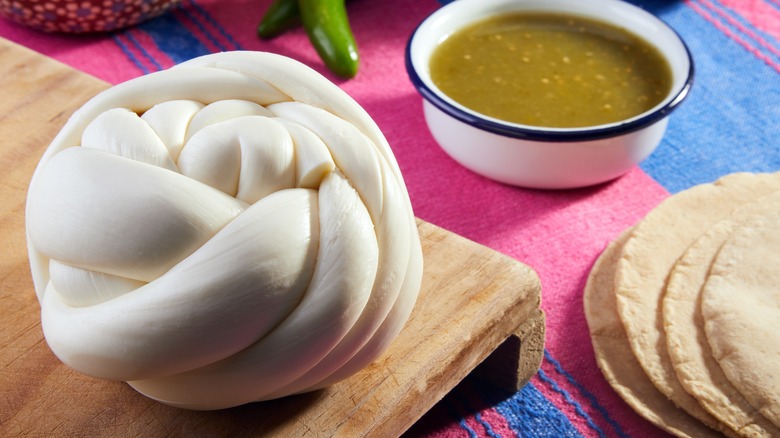13 Mexican Grocery Store Items You Likely Won't Find In A Typical US Supermarket
There are a lot of great things about being a foodie in the U.S., not least of which is our proximity to Mexico. Smoky, sweet, spicy, and surprising, Mexican cuisine is a varied tapestry of flavors formed by thousands of years of history and the mingling of different cultures. There's a long, complex history of cultural exchange between the U.S. and Mexico, and it's a story you can tell with food.
Mexican food was first introduced to the U.S. after the Mexican-American War, which resulted in a large portion of Mexico ceded to the U.S. Since then, millions of Mexican immigrants have come to the U.S., and Mexican food is now a wildly popular cuisine among Americans. In fact, salsa has been outselling ketchup since 1992.
While the influx of immigrants and the growing popularity of Mexican food have made Mexican ingredients more commonly available in U.S. grocery stores, there are still some that you'll have to find in Mexican grocery stores. The good news is that many cities across the U.S. have a sizable Mexican population, so these grocery stores are often easy to find and carry some essential Mexican ingredients that you'll need for your next taco night. Find out more about Mexican grocery store items you likely won't find in a US supermarket.
Epazote
Epazote isn't for everybody, and you certainly won't find it in a U.S. supermarket. In its native habitat of southern Mexico and Central America, this green herb grows like a weed and is found practically everywhere. Epazote has a distinct pungent, earthy flavor with hints of basil, mint, citrus, and anise. And if you can taste epazote in a dish, it's a good sign that you're in for an authentic Mexican culinary experience.
In southern Mexico, epazote is usually used in fresh dishes like beans and stews. A sprig of fresh epazote is sometimes folded into a cheese quesadilla as the flavor complements the earthiness of the corn tortilla. In the U.S., you're unlikely to find fresh epazote at your local supermarket, although you can sometimes find the dried version (less potent but gets the job done) in the Hispanic foods section. Mexican grocery stores usually sell it fresh in bunches, or if you've got a green thumb, you can buy epazote seeds online, and it's relatively easy to grow yourself. Also, people have been using epazote for hundreds of years to treat digestive issues, so if you've got an upset stomach, you can use the leaves to brew a medicinal tea.
Huitlacoche
At U.S. supermarkets, you're likely to find button mushrooms, criminis, and shiitakes, but there's a fungus called huitlacoche that you probably won't see in the produce aisle. Huitlacoche (also known as corn smut or corn fungus) grows on corn, which has been a staple crop in Mexico for thousands of years. While some farmers will destroy plants affected by the fungus, it's viewed as a delicacy in Mexico.
Mexico's huitlacoche corn fungus is prized by chefs for its complex flavor profile, which is reminiscent of a mushroom with savory notes of earthiness and umami. The spongy, slightly chewy texture makes it a good addition to quesadillas, tamales, and tacos. And vegetarians rejoice: Huitlacoche's texture makes it a great meat substitute, and it's full of protein, unsaturated fat, and lysine. Although huitlacoche is best fresh, it's very difficult to find in the U.S. because it doesn't travel well, and there's just not enough demand (yet) for robust local production. You can, however, find frozen huitlacoche at Mexican supermarkets.
Hoja santa
Hoja santa, which is Spanish for "sacred leaf," isn't the dainty little herb you might be used to. Sometimes called "root beer plant" or "Mexican pepperleaf," hoja santa leaves can grow up to almost a foot across. Its flavor is hard to pin down, but there are hints of mint, anise, black pepper, and sassafrass. For hundreds of years, the Aztecs used hoja santa to flavor chocolate-based beverages, and the plant was used as a digestive aid and pain reliever.
Hoja santa is native to southern Mexico, where it's commonly used as an edible wrapper for fish and meats. It's also used to flavor pozole and yellow and green mole, sauces commonly eaten in the Mexican state of Oaxaca. You're very unlikely to find hoja santa for sale at a typical U.S. supermarket, but if you live in a city with a large Mexican population, chances are you can find it at a specialty food store or a farmers market.
Nopales
Most Americans don't look at a cactus and think "yum!" But in Mexico, the pads of the prickly pear cactus, known as nopales, were eaten for hundreds of years by Aztecs before the arrival of Europeans. This spiky, drought-resistant plant even made its way onto Mexico's flag, which depicts an eagle eating a snake atop a prickly pear cactus.
While nopales are delicious raw (after removing the spikes, of course), they're typically cooked with eggs or used to fill tacos after they've been grilled or sauteed. They have a slightly tart, citrusy flavor and a crisp, gelatinous texture. On top of that, some research has shown that nopales may even reduce the symptoms of a hangover due to their anti-inflammatory properties. While the nopal is slowly making its way into mainstream American culinary culture, you still probably won't find it at a regular grocery store, although it's more likely in the southwestern U.S., where the plant grows naturally. For those of us living in chillier climates, jarred nopales are available at most Mexican grocery stores.
Chayote
While you might be used to the typical autumn lineup of hearty squashes like kabocha and butternut, chayote is a green summer squash with a vibrant green color and a fresh, light flavor that's almost like a cross between a potato and a cucumber. Chayotes grow naturally in southern Mexico and Central America where they've been part of the local diet since before the arrival of European settlers. And it's no wonder why these wrinkly green squashes have been popular for so long. Chayotes are packed with vitamins, antioxidants, and essential minerals.
And it's super easy to incorporate chayote into your diet; simply use it in place of starchy carbs like potatoes, plantains, or parsnips. You can roast it, use it in soup, or finely chop it raw and add it to your salad. If you live in a place with warm weather, you'll have better luck finding chayote at a grocery store or a farmers market. But even in the chilly Northeast, Mexican grocery stores often carry it.
Mexican oregano
If you're reading this and thinking: "I already have regular oregano. Do I really need to buy another kind?" Yes, you do. Although they're both called "oregano," Mexican oregano belongs to the verbena family while Mediterranean oregano is part of the mint family. They do share some common flavors, but what makes Mexican oregano different from the common variety is its markedly more pungent and citrusy flavor profile. Mediterranean or "regular" oregano tastes a bit mintier. The flavor of Mexican oregano (maybe unsurprisingly) just goes better with Mexican food.
A few dishes where Mexican oregano really shines are stews, enchiladas, and chicken tinga. You can also use it to make herbal tea. If you're in the U.S., you might have a harder time getting your hands on this unique spice, especially the fresh version. Sometimes you'll find dried Mexican oregano in the Hispanic foods section of a typical supermarket, but you'll almost certainly find it at a Mexican grocery store.
Masa harina
Of all the Mexican ingredients you can keep in your pantry, masa harina may just be the most indispensable. Making masa harina involves soaking corn kernels in a lime solution (a process called nixtamalization) and then grinding them into a fine powder used for a whole host of food products that are found throughout Mexico. The process of nixtamalization changes the flavor and color of the corn and, more importantly, increases the bioavailability of several important compounds that make the corn flour more nutritious.
In Mexico, masa harina is used to make tortillas, tamales, tlayudas, tacos, and tostadas, to name a few. Masa harina is so ubiquitous in Mexican cuisine that it would be difficult to spend a day eating in Mexico without encountering it. To those untrained in the ways of Mexican cuisine, using masa harina may seem intimidating, but it's actually quite simple, and there's nothing like a homemade tortilla. There are two common types of masa harina: white and yellow. While white masa harina is a little sweeter than yellow, the taste is similar and basically interchangeable. Masa harina can be found in some U.S. supermarkets with other types of flour, and it's available at virtually every Mexican grocery store.
Piloncillo
Piloncillo is made from just one ingredient: sugar cane. But people familiar with its distinct flavor know that piloncillo is much more than just sugar. Made by boiling sugar cane juice into a thick syrup that is poured into a distinctive conical mold, piloncillo has a rich flavor with notes of molasses and burnt caramel. Because of its strong taste, piloncillo is used for its flavor as well as its sweetness.
It's often used to sweeten beverages like atole (a traditional Mexican beverage made with masa harina) and café de olla (coffee infused with spices like cinnamon and cloves). Piloncillo is also widely used in baked goods like flan and cookies. One common misconception is that piloncillo is a form of brown sugar. Although they share some flavor characteristics, piloncillo is unrefined while brown sugar is just refined sugar with molasses added to it. That said, if a recipe calls for piloncillo and you don't have any on hand, using brown sugar is your best bet.
Achiote
If you've been to Mexico City, you've probably seen the hypnotizing movement of a spit of al pastor meat at a taqueria. The distinctive red color of al pastor comes from achiote, a spice mixture made with annatto seeds that is used for its flavor as well as its bold color. The annatto tree is native to tropical Latin America, and the dark reddish-brown seeds have been used in the region since before the arrival of Europeans to make ink, body paint, and even insect repellent.
To make achiote, annatto seeds are blended with cumin, oregano, garlic, pepper, cloves, and coriander. Available as a paste or a powder, achiote is typically associated with Mexico's Yucatán region and particularly with cochinita pibil, a slow-roasted pork dish made with achiote. The spice mixture has a peppery, earthy, mildly nutty taste that pairs particularly well with meat dishes, which is how it's most often used. If you can't find achiote in the Hispanic foods section of your local grocery store, it's offered at most Mexican grocery stores. Alternatively, you can make your own homemade achiote paste if you buy annatto seeds, which are sometimes available at Latino grocery stores or online.
Mexican chocolate
Chocolate is more than just a sweet in Mexico; it is an important part of Mexican cultural heritage. And Mexican chocolate doesn't typically just refer to chocolate from Mexico but a mix of cacao nibs, cinnamon, sugar, and sometimes other ingredients like nuts, chilies, and spices that are compacted into a disc shape. The most common way to consume Mexican chocolate is by breaking off a piece and making hot chocolate or champurrado, a thick beverage made with masa harina. Hot chocolate has a long history in Mexico that dates back to the Aztecs, who drank it in religious rituals as a symbol of fertility and abundance.
And if you're looking to make more Mexican cuisine, Mexican chocolate discs are the ingredient your pantry is missing. While we typically associate chocolate only with sweet desserts, in Mexico, it's commonly used in savory mains, most famously in mole, a chocolate-based sauce often used to top chicken and enchiladas.
Mexican crema
If you've had authentic Mexican enchiladas, you're probably familiar with the creamy tang of Mexican crema. Crema was brought to Mexico by European settlers and it has since become an important ingredient in several Mexican dishes. Crema is similar to sour cream but with a higher fat content and a smoother, less acidic flavor. While sour cream is made by adding bacterial cultures to cream, crema is usually made by fermenting buttermilk and heavy cream, which explains the difference in flavor and texture. Its thinner consistency makes crema perfect for drizzling.
You can find Mexican crema at almost any Mexican grocery store, and you'll find that it's a perfect accompaniment to notoriously spicy Mexican cooking because it counters the heat with its cool creaminess. If you can't get your hands on Mexican crema, you can substitute a mixture of crème fraîche. You can use crema to top tacos, fajitas, soups, and enchiladas.
Oaxaca cheese
If you love melted cheese (and, let's be honest, who doesn't?), then it's time you tried queso Oaxaca. Named after the state in southern Mexico where it originated, Mexico's stretchy Oaxaca cheese stands out from the rest because of its firm texture that becomes perfectly gooey when melted. If you're trying to make the perfect quesadilla, look no further than a ball of Oaxaca cheese.
The process for creating this cheese, which is similar to mozzarella, is believed to have been brought to Mexico by Spanish settlers in the 16th century. Though legend has it that in the late 1800s, a 14-year-old girl in the village of Reyes Etla charged with overseeing cheese production got distracted and let it coagulate for too long. This accident created a culinary phenomenon, and Oaxaca cheese is now used throughout the country. Finding Oaxaca cheese at a typical U.S. supermarket can be hit or miss, but if you live in an area with a sizable Mexican population, you can easily buy it at any Mexican grocery store.
Chile de arbol
Mexican cuisine is famous for being spicy. The climate in many parts of Mexico is perfect for chili peppers, and they've been part of the regional diet for thousands of years. The distinctly smoky taste of a dark red salsa at a Mexican restaurant typically comes from chile de árbol. Native to Mexico, these slender chili peppers pack a punch. On the Scoville scale, which ranks spiciness, chile de árbol is similar to cayenne pepper. But these powerful little peppers are about more than just heat. Chile de árbol has a distinctly smoky, nutty, savory flavor that adds depth and intensity to a red salsa.
Beyond salsa, there are several creative uses for chile de árbol. You can add it to mashed potatoes or cornbread to give them a kick or infuse a broth with spicy smokiness. You can also use them in an adobo sauce instead of chipotle peppers if you're looking for a more intense spiciness.
